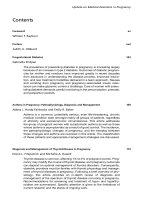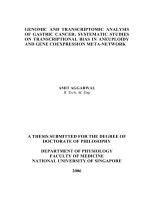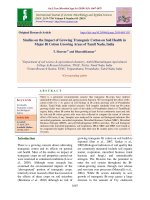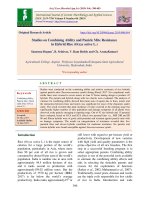Pathomorphological studies on hepatic disorders in sheep
Bạn đang xem bản rút gọn của tài liệu. Xem và tải ngay bản đầy đủ của tài liệu tại đây (422.06 KB, 7 trang )
Int.J.Curr.Microbiol.App.Sci (2020) 9(11): 294-300
International Journal of Current Microbiology and Applied Sciences
ISSN: 2319-7706 Volume 9 Number 11 (2020)
Journal homepage:
Original Research Article
/>
Pathomorphological Studies on Hepatic Disorders in Sheep
H. J. Kiran*, G. M. Jayaramu, B. Kavitha Rani, S. S. Manjunatha and E. S. Satish
Department of Veterinary Pathology, Veterinary College, KVAFSU, Shivamogga, India
*Corresponding author
ABSTRACT
Keywords
Liver, Disorders,
Sheep
Article Info
Accepted:
04 October 2020
Available Online:
10 November 2020
Most of the septicaemic diseases in small ruminants affect liver, as most of the blood pass
through this organ. Major sources of etiologies/ afflictions are from pathogenic organisms,
nutrition, xenobiotics or toxins whose effects are varied, which may be localized or
generalized, cumulative or chronic, acute, sporadic or outbreaks etc. Liver is vulnerable to
many parasitic infections and helminthic diseases such as Fasciolosis, Cysticercosis,
Hydatidosis and Stilesia hepatica make liver unsuitable for human consumption due to
condemnation upon meat inspection. A total of 110 sheep mortalities were necropsied and
of which 105 livers showing abnormalities were noted. The most frequent lesions observed
were congestion (73.33%) followed by cell swelling (23.81%), haemorrhage (21.90%),
hydropic degeneration (18.09%), coagulative necrosis (18.09%), acute focal hepatitis
(14.28%), fatty change (8.57%), biliary hyperplasia (6.67%), acute multifocal hepatitis
(5.71%), chronic hepatitis (3.81%), thrombosis (0.95%) and hepatic abscess (0.95%) in
liver.
wool respectively, to the national economy
(FAOSTAT, 2014).
Introduction
Sheep farming is one of the important
agriculture based activities, practiced by a
large section of farmers in developing
countries like India, which plays an important
role not only in income generation but also in
improving
the
household
nutrition.
Government of India encourages farming of
small ruminants towards achieving food
security. India ranks third in the world with a
sheep population of 75 million with an
estimated annual meat production at 4 million
tonnes and 47.9 million kgs of wool. Sheep
farming contributes about 43,232 crores and
403 crores of Indian rupees through meat and
Numerous factors are responsible for
economic losses in the sheep industry. Among
them, problems related to health are of utmost
importance. The small ruminant population in
our country is frequently exposed to ravages
of infectious diseases, which is of major
constraint in sheep production.
Most of the septicaemic diseases in small
ruminants affect liver as most of the blood
pass through this organ. Major sources of
etiologies/ affections are from pathogenic
organisms, nutrition, xenobiotics or toxins
294
Int.J.Curr.Microbiol.App.Sci (2020) 9(11): 294-300
whose effects are varied, which may be
localized or generalized, cumulative or
chronic, acute, sporadic or outbreaks,
etc.Liver is vulnerable to many parasitic
infections and helminthic diseases such as
Fasciolosis, Cysticercosis, Hydatidosis and
Stilesia hepatica make liver unsuitable for
human consumption due to condemnation
upon meat inspection.
Histopathological classification of lesions in
liver
The lesions recorded in the liver were
classified as described earlier based on
inflammation and the principal constituent of
the exudates. These include vascular/
circulatory changes, degenerative and necrotic
changes, inflammatory changes, growth
adaptive changes / responses (Mason and
Madden, 2007).
In addition, liver abscesses caused by
bacterial septicaemia represent another major
reason for meat condemnation (Tehrani et al.,
2012). In these geographical areas, sheep
husbandries mainly comprise nomadic
practices and hence, etiologies responsible for
sheep mortalities are often unknown or
obscure.
Results and Discussion
Based on gross and histopathological features,
hepatic disorders were grouped as circulatory
changes, degenerative and necrotic changes,
inflammatory changes and others. In the
present study, 105 cases (95.45 %) of liver
showed pathologies were recorded.
Materials and Methods
Circulatory disturbances
Out of 110, 105 samples from sheep showing
liver lesions were collected regardless of the
age, sex and breed.Carcasses of slaughtered
and necropsied sheep were examined. A
detailed gross examination of liver with
respect to size, color and consistency were
collected.
In the present study, circulatory disturbances
in liver comprised of congestion (73.33%),
haemorrhages (21.90%) and thrombosis
(0.95%). Bhavyapriyanka (2017) recorded a
lower occurrence of 2.24 per cent of
congestion whereas Khan et al., (2015)
recorded a higher occurrence of 47.36 per
cent of haemorrhages. Congestion was found
to occur frequently in sheep belonging to
nomadic herds which could be attributed
exposure to various toxic agents through
ingestion of environmental toxicants or plants
during migratory period. Chronic venous
congestion of liver occurs commonly due to
stagnation of blood within the central vein
and adjacent sinusoids with subsequent fatty
degeneration of peripheral hepatocytes
because of hypoxia. Hepatic congestion is
reported to occur due to either infectious
causes (Omotainse and Anosa, 2009) or noninfectious causes (Ozmaie et al., 2013). Liver
with congestion appeared dark red grossly
and blood oozed out freely from the cut
surface. Microscopically, congestion of
Representative tissue samples fixed in 10%
neutral buffered formalin were processed by
routine paraffin-embedding technique and 4-5
µm thick sections were stained by routine
Haematoxylin and Eosin (H&E) for detailed
histopathological studies. In selected cases,
adjacent sections of tissue samples were
stained using special staining techniques
which included Gram's staining for bacteria
and Masson's trichrome for collagen
(Luna,1968).
The stained sections will be examined under
bright field microscope and documented. The
results of gross and histopathology will be
analysed and interpreted.
295
Int.J.Curr.Microbiol.App.Sci (2020) 9(11): 294-300
vascular and sinusoids along with hydropic
degeneration of hepatocytes, fatty changes,
haemorrhages and thrombosis were noticed
(Fig. 1 & 4).
Microscopically, the hepatocytes were
enlarged with the presence of small multiple
clear or pale vacuoles, within the cytoplasm
and a normal nucleus in central position
which appeared like ‘bull eye’ (Fig. 2), which
is well in accordance with those described by
Hassanein et al., (2017). Hydropic
degeneration could be seen after exposure of
liver to various toxin, hypoxia and anaemia,
which is in agreement with the reports of
earlier workers (Thannon, 2018).
Occurrence of haemorrhage might be due to
various systemic disorders like cardiac and
pulmonary lesions, plant poisoning or
hemorrhagic septicemia (Ozmaie et al., 2013;
Verma, 2014). Microscopically, either
petechial or ecchymotic haemorrhages were
observed in this study which revealed focal
areas of haemorrhages (Fig. 1) which is in
conformity with the findings of Arafat et al.,
(2015).
In the present study, fatty change was
observed as associated lesions in conditionof
plant poisoning and cardiac cirrhosis. Fatty
change was reported to be a common finding
in cases of toxemia, anemia and hypoxia
(Thannon, 2018). Grossly, fatty livers were
enlarged with rounded borders, the affected
part being soft, greasy and yellow in color
(Fig. 3). Microscopically, clear, round
globules were noticed within the cytoplasm of
hepatocytes (Fig. 4). Gross and microscopic
observations are well in accordance with
those described by Abed (2012) and Kumar et
al., (2013). Fat accumulation is a sensitive
response to hepatocellular injury and can
occur in the absence of other obvious
alteration in hepatic structure and function
(Jubb et al, 2007).
Thrombosis could be seen in severe
congestion, bacterial or parasitic infections
(Fig. 1). Along with thrombosis, focal
hepatitis, coagulative necrosis with congested
central and portal vessels were also noticed,
which is in argument with findings of Kumar
et al., (2013).
Degenerative and necrotic changes
In the present study, degenerative changes
comprised of hepatic cell swelling (23.81%),
hydropic degeneration (18.09%), fatty
changes (8.57%) and coagulative necrosis
(18.09%). Khan et al., (2015) recorded a
higher occurrence of hepatic cell swelling
with 52.63 per cent. Hassanein et al., (2017)
recorded a lower occurrence of hydropic
degeneration at 0.002 per cent. Sarkar (1998)
recorded a similar occurrence of fatty changes
at 8.5 per cent of fatty changes.
Occurrence of coagulative necrosis in the
present study could be due to Babesiosis or
pregnancy toxaemia. Grossly, liver was dark
reddish in color with necrotic patches.
Microscopically,
hepatocytes
were
homogenously pink in color with absence of
nuclei (Fig. 8). The recorded observations
were similar to those described by Zangana
and Aziz (2012), Thannon (2018) and
Hamond et al., (2019).
Microscopically, hepatic cell swelling revealed
cytoplasmic
granulation
and
reduced
sinusoidal spaces were seen. In some cases, the
adjacent areas showed hydropic degeneration
and necrotic changes (Fig. 2). The recorded
observations are well in accordance with those
described by Tafti et al., (2008).
Inflammatory changes
In the present study, inflammatory condition
of liver comprised of acute hepatitis (20%),
296
Int.J.Curr.Microbiol.App.Sci (2020) 9(11): 294-300
chronic hepatitis (3.81%) and hepatic abscess
(0.95%). Gezu and Addis (2014) recorded a
similar occurrence of acute hepatitis at 19.8
per cent. Regassaet al., (2013) recorded a
higher occurrence of chronic hepatitis
42.10per cent. Tehrani et al., (2012) recorded
a higher occurrence hepatic abscess at 4.6 per
cent.
those described by Al-Nassir (2014) and
Hamond et al., (2019). In the present study,
the occurrence of chronic hepatitis at 3.81 per
cent might be because of coccidiosis,
hemorrhagic septicemia or plant poisoning.
Arafat et al., (2015) reported cirrhosis as end
stage of liver and occurs because of bacterial
infection. Grossly, the liver was enlarged with
a mottled surface, fibrosis and nodule
formation. Microscopically, massive necrosis
with atrophy, fibrosis and accumulation of
mononuclear inflammatory cells such as
lymphocytes, macrophages and plasma cells
were seen (Fig. 6). These findings are in
conformity with the findings of Dharvadiya et
al., (2014).
Microscopically, acute hepatitis showed
marked congestion, focal necrosis and
accumulation of neutrophils within sinusoids
and in the parenchyma were the salient
microscopic findings along with infiltration of
inflammatory cells in the portal areas (Fig. 5
& 1). The recorded observations are similar to
Table.1 A comparison of histopathological conditions in liver of sheep mortalities
Sl. No.
1.
2.
3.
4.
Conditions
Circulatory disturbances
Congestion
Haemorrhage
Thrombosis
Degenerative and necrotic changes
Cloudy Swelling
Hydropic Degeneration
Fatty change
Coagulative necrosis
Inflammatory conditions
Acute hepatitis
a. Focal acute hepatitis
b. Multifocal acute hepatitis
Chronic hepatitis
Abscess
Other condition
Bile duct hyperplasia
297
No. of cases
% (N=105)
77
23
01
73.33
21.90
00.95
25
19
09
19
23.81
18.09
08.57
18.09
15
06
04
01
14.28
05.71
03.81
00.95
07
06.67
Int.J.Curr.Microbiol.App.Sci (2020) 9(11): 294-300
Fig 2:Microphotograph of liver showing hydropic
degeneration, enlarged hepatocytes with presence of
small clear, pale multiple vacuoles, cloudy swelling
acute portal hepatitis.H&E x 100
Fig 1: Microphotograph of liver, showing thrombosis,
red blood cells alternating with fibrin in the central vein
along with focal hepatitis, congestion and haemorrhagic
changes. H&E x 40
Fig 4:Microphotograph of liver showing fatty change,
presence of small clear fat globules in the cytoplasm of
hepatocytes along with mild degeneration and
congestion of central vein.H&E x 200
Fig 3: Gross photograph of liver showing fatty change,
distended gall bladder, enlarged liver with rounded
border.
Fig 5:Microphotograph of liver showing acute
multifocal hepatitis, infiltration of inflammatory cells,
and bile duct hyperplasia.H&E x 100
Fig 6: Microphotograph of liver showing chronic
hepatitis. showing, the connective tissue (blue)
proliferation around portal tract and congestion of
hepatic vessels. MST x 40
Fig 7: Microphotograph of abscess smear showing
Fusobacterium spp., that are Gram negative, with long
and short rods sometimes showing curling and
tangling.Gram’s x1000
Fig 8: Microphotograph of liver showing bile duct
hyperplasia, severe destruction in the liver tissue
including necrosis and proliferation of numerous small to
large sized bile ducts. Also note portal congestion and
mild inflammation. H & E 100
H&E x 100
Fusobacterium spp. was demonstrated from
smear of abscess (Fig. 7), which was
supported by Khaled-Al-Qudahand Ahmad
(2003). Bacteria can reach liver via a number
of different routes and induce the formation of
abscesses that includes portal vein, the
umbilical vein in neonants, generalized
bacteremia reaching the liver via the hepatic
artery, an ascending infection of the biliary
system by parasitic migration as a direct
extension of an inflammatory process from
tissues such as the reticulum immediately
adjacent to the liver (Khaled-Al-Qudah and
Ahmad, 2003). Grossly, liver showed large
298
Int.J.Curr.Microbiol.App.Sci (2020) 9(11): 294-300
M. E., Ruba, T., Alam, K. J., Hossain, M.
I., and Hossain, M. M., 2015. Abattoir
survey on the liver diseases of sheep in
Mymensingh municipality area in
Bangladesh. Vet. Med. Rec., 1(2): 105110
Bhavyapriyanka, P., 2017. Pathological studies
on spontaneous lesions in slaughtered
sheep. M.V.Sc. thesis, Sri Venkateswara
Veterinary University Tirupati, India
Cherian, S., Placid, E. D’souza., Renuka,
Prasad, C., and Suguna, Rao, 2010.
Histopathological observations in ovine
schistosomosis. J. Vet. Parasitol., 24(2):
129-131
Dharvadiya, N. S., Joshi, D. V., Patel, B. J.,
Raval, S. H. and Patel, J. G., 2014.
Pathomorphological
studies
on
spontaneously occurring hepatic lesions
in sheep (Ovis aries). Rumin. Sci., 3(1):
41-43
FAOSTAT: Food and Agriculture Organization
Statistics., 2014. Statistical data base of
livestock. Rome, Italy
Gezu, M. and Addis, M., 2014. Causes of liver
and
lung
condemnation
among
apparently healthy slaughtered sheep and
goats at Luna abattoir, Modjo, Ethiopia.
Adv. Biol. Res., 8: 251-6
Hamond, C., Silveira, C. S., Buroni, F., Suanes,
A., Nieves, C., Salaberry, X., Aráoz, V.,
Costa, R. A., Rivero, R., Giannitti, F. and
Zarantonelli, L., 2019. Leptospira
interrogans serogroup Pomona serovar
Kennewicki infection in two sheep flocks
with acute leptospirosis in Uruguay.
Transbound. Emerg. Dis.,1: 5-8
Hassanein, K. M., Sayed, M. M. and Hassan, A.
M., 2017. Pathological and biochemical
studies on enterotoxemia in sheep. Comp.
Clin. Path., 26(3): 513-518
Jubb, K. V. F., Kennedy, P. C. and Palmer, N.,
2007. Pathology of domestic animals.
Edn. 5th, Academic Press, New York and
Landon., pp 259-447
Khaled-Al-Qudah, and Al-Majali, Ahmad.,
2003. Bacteriologic studies of liver
abscesses of Awassi sheep in Jordan.
Small Rumin. Res., 47(3): 249-253
abscess, which had a connecting tract with a
hard dried onion patterned mass at right
abdominal region in sheep. Microscopically,
abscess had a thick cellular detritus in the
center surrounded by cellular infiltration
consisting mainly lymphocytes with few
polymorphs at the inner margin of the
abscesses and surrounded by a thick fibrous
tissue. Similar to the present study, single to
multiple abscesses were recorded in liver by
earlier researchers (Sonawane et al., 2016;
Al-Taee et al., 2017).
Other conditions
Bile duct hyperplasia was observed in 6.67
per cent of cases. Khan et al., (2015) recorded
a higher occurrence at 19.70 per cent.
Microscopically, it is associated with severe
destruction of the liver tissue including
inflammation, atrophy, necrosis, fibrosis and
hyperplasia of the bile ducts (Fig. 8). The
lesion of biliary hyperplasia has been
described by many workers to be association
with cirrhosis (Cherian et al., 2010 and Khan
et al., 2015). However, in the present work,
lesions of bile duct hyperplasia were seen
along with acute and chronic hepatitis.
References
Abed, F. M., 2012. A pathological study of
lesions in the liver of sheep in abattoir of
Kirkuk province. Europ. J. Appl.
Sci.,4(4): 140-145
Al-Nassir, H. S., 2014. A surveillance study on
condemnation of ruminant's livers and
lungs due to common disease conditions
in Kerbala abattoirs. Kufa J. Vet. Med.
Sci., 5(1): 22-30
Al-Taee, E. H., Al-Naimi, R. A., Znad, K. H.
and Al-Tamimi, A. A., 2017. Study the
histopathological
changes
and
bacteriological causes of natural infection
of the livers in sheep at Diyala Province.
Diyala J. Pure Sci., 13(4): 12-22
Arafat, M. S. H., Aktar, M., Rashid, M., Kabir,
299
Int.J.Curr.Microbiol.App.Sci (2020) 9(11): 294-300
Khan, S. A., Muhammad, S., Khan, M. M. and
Khan, M. T., 2015. Study on the
prevalence and gross pathology of liver
fluke infestation in sheep in and around
Quetta District, Pakistan. Adv. Anim.
Vet. Sci., 3(3): 151-155
Kumar, J., Sonawane, G. G., Tripathi, B. N.,
Meena, A. S., Singh, F. and Dixit, S. K.,
2013.
Bilateral
mixed
bacterial
pyelonephritis in a crossbred sheep.
Indian J. Small Rumin., 19: 61-6
Luna, L. G., 1968. Manual of histologic staining
methods of the armed forces institute of
pathology. 3 Mc Graw Hill book Co,
New York, U. S. A., pp 1-92
Mason, G. L. and Madden, D. J., 2007.
Performing
the
field
necropsy
examination. Vet.
Clin.
North
Am., 23(3): 503-526
OMOTAINSE, S.O. andANOSA V.O., 2009.
comparative histopathology of lymph
nodes, spleen, kidney and liver in
experimental
trypanosomiasis.
Onderstepoort J. Vet. Res., 76: 377-383
Ozmaie, S., Akbari, G., Asghari, A., Sakha, M.
and Mortazavi, P., 2013. Experimental
oleander (Nerium oleander) poisoning in
sheep: Serum biochemical changes and
pathological study. Ann. Biol. Res., 4(1):
194-198
Regassa, A., Moje, N., Megersa, B., Beyene,
D., Sheferaw, D., Debela, E., Abunna, F.
and Skjerve, E., 2013. Major causes of
organs and carcass condemnation in
small ruminants slaughtered at Luna
Export Abattoir, Oromia Regional State,
Ethiopia. Prev. Vet. Med., 110(2): 139148
Sarkar, S., 1998. Pathology of ovine liver.
Indian J. Vet. Pathol., 22(1): 79
Sonawane, G. G., Kumar, J. and Sisodia, S. L.,
2016. Etio-pathological study of multiple
hepatic abscesses in a goat. Indian J. Vet.
Pathol., 40(3): 257-260
Tafti, A. K., Nazifi, S., Rajaian, H.,
Sepehrimanesh, M., Poorbaghi, S. L. and
Mohtarami, S., 2008. Pathological
changes associated with experimental
salinomycin toxicosis in sheep. Comp.
Clin. Pathol., 17(4): 255-258
Tehrani, A., Javanbakht, J., Hassan, Mamh.,
Zamani, M., Rajabian, M., Akbari, H.
and Shafe, R., 2012. Histopathological
and bacteriological study on hepatic
abscesses of herrik sheep. J. Med.
Microb. Diagn., 1(4): 32-41
Thannon, H. B., 2018. pulmonary and hepatic
lesions in slaughtered sheep in Mosul
city. Tikrit. J. Pure Sci., 22(6): 25-33
Verma, D., 2014. Enteropathology in goats with
special
reference
to
enterotoxaemia. M.V.Sc. thesis, Nanaji
Deshmukh
Viterinary
Science
University, Jabalpur
Zangana, I. K. and Aziz, K. J., 2012. Prevalence
and pathological study of schistosomiasis
in sheep in Akra/Dohuk province,
northern Iraq. Iraq J. Vet. Sci., 26: 125130.
How to cite this article:
Kiran, H. J., G. M. Jayaramu, B. Kavitha Rani, S. S. Manjunatha and Satish, E. S. 2020.
Pathomorphological Studies on Hepatic Disorders in Sheep. Int.J.Curr.Microbiol.App.Sci.
9(11): 294-300. doi: />
300









